When? And, as if….! And getting there!
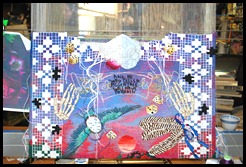
Somehow this has become the piece that doesn’t want to end. It’s not that I am not putting time into it, because for the last 3 weeks I have averaged 6 hours a day 4-5 days a week.
Granted, I added another inch to it when I realized I had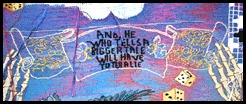 mis-measured and I was going to be short in my geometric lace pattern. My pattern was 3/4th of an inch short, but still…I have been working on this piece longer then any other piece I have ever woven. The finished piece will be approx. 28 inches by 19 inches-give or take .5 to 1 inch taller. A total of 812 square inches-give or take a bit when finished. Yes, that does count the 19 extra square inches added because of the lace.
mis-measured and I was going to be short in my geometric lace pattern. My pattern was 3/4th of an inch short, but still…I have been working on this piece longer then any other piece I have ever woven. The finished piece will be approx. 28 inches by 19 inches-give or take .5 to 1 inch taller. A total of 812 square inches-give or take a bit when finished. Yes, that does count the 19 extra square inches added because of the lace.
So how did this happen.
I’ve been weaving on “AND He…”since July of 2011. I guess it only seems longer. I did  weave 2 small tapestries while working on it –one with rya. And, I wove for 4 or 5 months more or less 3 days a week on Shelley’s piece. This time last year was I working on the two a chromatic roses.
weave 2 small tapestries while working on it –one with rya. And, I wove for 4 or 5 months more or less 3 days a week on Shelley’s piece. This time last year was I working on the two a chromatic roses.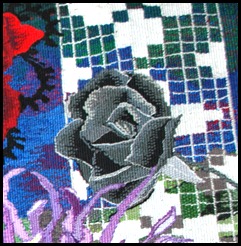
Up side down, because the piece wraps around my Mirrix Zeus.
The weights hanging down are being used to keep two replaced warps at the proper tension while I weave.
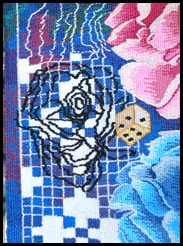
My assessment of the things I have Learned while weaving this piece and should have thought out-better.
1. I don’t especially enjoy weaving this large of a format. I am happiest weaving pieces under 15 x10 inches or smaller. I should have thought more about the difference between scale and format and that I was headed for dragon robe territory and a life time commitment of finishing one piece… 
2. It’s difficult for me to weave a piece if I can’t see the beginning as I weave. It fragments the narrative and energy in my mind. It sucks the joy out of the process of weaving. It becomes a chore that all I can think about is finishing the piece not the journey which is the wonderful part of tapestry weaving for me. Thanks for pointing this out to me Andrea*. I don’t have this problem working on a large loom and piece when it rolls around the beam for some reason and I have a lot of experience working on very large wool pieces.
( Andrea Furber, a good friend who happens to be a pranic healer. Thanks Andrea-the energy is so much better now!)
3. I am a story teller at heart. I may not care if others understand my imagery or symbols, but the pieces I design are a narrative usually of something in my life and need to be a complete thought-even when I weave in a series. Series function as chapters of  the my personal narrative. My sunsets are colour studies even when included in a narrative piece. I am happiest when images float on the background. A sensibility I inherited from both of my grandmothers that honours the needlework traditions of one and the ethnic sensibilities of the other. Think fancy embroidered tea towels and Lakota painting and bead work-no real backgrounds images float on a usually plain background.
the my personal narrative. My sunsets are colour studies even when included in a narrative piece. I am happiest when images float on the background. A sensibility I inherited from both of my grandmothers that honours the needlework traditions of one and the ethnic sensibilities of the other. Think fancy embroidered tea towels and Lakota painting and bead work-no real backgrounds images float on a usually plain background.
4 . I should have set down and calculated the square inches of the piece before I started and made an informed decision. Perhaps broken the narrative into 4-5 pieces-a series of chapters. My average piece is around 100 square inches 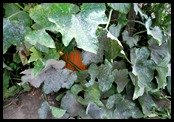 or less. I was so focused on doing the design, because it was one I started in wool at 10 epi when I had my 6.5 foot Shannock that I failed to consider the consequences. AND, I felt I needed to prove to myself that size and complexity doesn’t make difference in the format and scale of one of my designs-note I said in my designs. I wanted it to be exactly half the size of the one I would woven as 10 epi and twice the size. Mentally, I never focused on
or less. I was so focused on doing the design, because it was one I started in wool at 10 epi when I had my 6.5 foot Shannock that I failed to consider the consequences. AND, I felt I needed to prove to myself that size and complexity doesn’t make difference in the format and scale of one of my designs-note I said in my designs. I wanted it to be exactly half the size of the one I would woven as 10 epi and twice the size. Mentally, I never focused on the size of the piece. I checked my journals to see if I had written or thought out what the size entailed-an unthought consequence. Bad mistake! Until Pat, John and Spencer, and I were eating lunch at the Calapoia Brewery a week ago. (One of our favourite hang outs even though we don’t drink what they brew, and have the best soups in the world-they don’t care how long we sit and talk and the food is great and it’s only 5 blocks from the studio…) Anyway, onward, I was in the process of whining about how I couldn’t seem to finish the piece. I needed to move on to the next piece, etc., etc., etc. Not
the size of the piece. I checked my journals to see if I had written or thought out what the size entailed-an unthought consequence. Bad mistake! Until Pat, John and Spencer, and I were eating lunch at the Calapoia Brewery a week ago. (One of our favourite hang outs even though we don’t drink what they brew, and have the best soups in the world-they don’t care how long we sit and talk and the food is great and it’s only 5 blocks from the studio…) Anyway, onward, I was in the process of whining about how I couldn’t seem to finish the piece. I needed to move on to the next piece, etc., etc., etc. Not my usual whiney stuff-of which I am not proud of, but whining happens to the best of us at one time or another. John asked me how many square inches was in the piece and what was my usual square inches were that I usually wove a piece. It was then I knew how I left out an important part of the design process. OUCH!!! I KNOW BETTER OR I SHOULD!! Size or format really at some point is important to think about in the design process. Not just if the size will fit on the loom.
my usual whiney stuff-of which I am not proud of, but whining happens to the best of us at one time or another. John asked me how many square inches was in the piece and what was my usual square inches were that I usually wove a piece. It was then I knew how I left out an important part of the design process. OUCH!!! I KNOW BETTER OR I SHOULD!! Size or format really at some point is important to think about in the design process. Not just if the size will fit on the loom.
5. Unless I want to give the piece away I’ll probably never make my time or money back on the piece. It’s roughly a 45,000 dollar piece at the rate I calculate what a piece should cost when I sell it. So I probably-most likely created an unsalable white elephant.
| A white elephant is an idiom for a valuable but burdensome possession of which its owner cannot dispose and whose cost (particularly cost of upkeep) is out of proportion to its usefulness or worth. In modern usage, it is an object, scheme, business venture, facility, etc., Liberated from Wikipedia  |
6. Another consideration-I can show a years work for approximately 2 years according to most shows and exhibits that I enter. Basically, because of the two year thingy and how little I produced in the last year  it will take me anther year of work to come up with a large enough body of new work that I can show to have enough piece to enter the shows I wish to enter.
it will take me anther year of work to come up with a large enough body of new work that I can show to have enough piece to enter the shows I wish to enter.
7. I need to sell my Mirrix Zeus and buy a smaller mirrix or even two smaller Mirrix. For 3 reasons—
1st reason– mistakes such as working too large are soon forgotten a little like child birth once it’s over you forget the pain and sign up to do it again. And, surprise it’s still just as painful as the first time! Some mistakes one never learns from and I seem to be doomed to repeat mistakes over and over. Better to loose the temptation then repeat the suffering.
and I seem to be doomed to repeat mistakes over and over. Better to loose the temptation then repeat the suffering.
2nd reason. At really tight tension and 20-22 ends per inch the shed gets narrower and narrower from one side to the other side. I have the feeling that over time the really tight tension will cause metal fatigue of the heddle bar. The metal fatigue being on the heddle bar not the frame of the loom. The frame really stands up to to the torture of the tight tension. Especially, If I am working narrower warps in the center of the loom. This one was 19 inches wide by 28 inches tall, which left roughly 7.5 inches on either side of the weaving. This heddle/shed problem is probably more likely if the piece has a smaller warp sett and the tension is adjusted tighter and left longer over time with a lot of beating along the fell line. Doesn’t happen on the smaller mirrix and I don’t think it would happen at larger warp setts on the Zeus.
3rd reason the longer or further the spring is pulled the more error in the epi when stretched the full width of the warp. The spring allows a shift to a greater or larger epi. Example 18 epi instead of 20-22.So the epi can change as much as 4 ends per inch on the far  side of the Zeus-either greater or lesser. There are things one can do such as keep checking the warp epi distance, Measure out the amount of spring curls and mark them. Then mark the beam and make sure the mark on the spring curl stays aligned with the mark on the beams by tying the spring several times along it’s length so it can’t ship. Or, buying a
side of the Zeus-either greater or lesser. There are things one can do such as keep checking the warp epi distance, Measure out the amount of spring curls and mark them. Then mark the beam and make sure the mark on the spring curl stays aligned with the mark on the beams by tying the spring several times along it’s length so it can’t ship. Or, buying a  heavier spring that is less flexible and adapt it to the Zeus. I checked my Hagen looms and realized the spring was much heavier and less likely to shift.
heavier spring that is less flexible and adapt it to the Zeus. I checked my Hagen looms and realized the spring was much heavier and less likely to shift.
Even with the 2nd and third reasons I still think the mirrix looms are the best looms readily available for small format tapestry weaving. I’ll just trade it for a smaller mirrix or 2.
8. I need to but a molding around the edge of the console table that I work on. The more desperate I have become to finish this piece the klutzier I have become. I am so tired of picking tools, extra bobbins-not attached to the weaving, spools of thread that I knock off the table while weaving that I am going to at least get rid of that problem. . I am sure this simple solution of putting a molding around the table will benefit my sanity and do way with the incredible amount of lost weaving time due to an over abundance of dysfunctional tool pickup time and stuff stuff due to searching for things that roll and try to escape.
| The above pictures are from my new herb gardens that are raised 2.5 feet off the ground. And one is a picture of the first pumpkin that I have ever grown. Thought it would be fun to have my own pumpkin for Thanksgiving pumpkin pies and soufflé. The other 2 pictures are my new raised herb gardens that I have spent so much time on this summer.. The picture of Chene is all about his trying to get my attention while I am trying to ignore all distractions and keep on weaving. |
FUN & MAGIC STUFF- I have actually get to do some fun thing’s while weaving on the piece that doesn’t want to end.
Amazingly I took 4 days of silversmithing with  Don Norris while he was here in Albany. Produced 2 rings and some great samples to work of techniques to work from.
Don Norris while he was here in Albany. Produced 2 rings and some great samples to work of techniques to work from.
I was also able to see and do samples of some pretty interesting things. That I am sure will eventually show up in my silver work.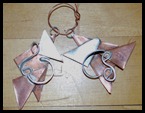
Mixed metals-copper,brass,and silver earrings. Not polished-still show soldering marks. Which will allow me to do this.

Wire soldering of larger more complex pieces. I am really wanting to learn to do filigree boxes for my tapestries, but needed more information on soldering more complex thin wire pieces.So this was a good start towards those skills.
An aha magic trick of melting fine silver through copper to create holes and silver ridges.
Another trick of putting t-pins into the pickle with soldered copper pieces and the pickle sort of electroplates the copper to the silver solder.
I know these aren’t much and the aha’s are basic chemistry and physics, but to me they are still magical when I see them happen. It’s still very like my first discovery in metal work. With enough heat all mistakes melt away and become a spherical ball that can be reused to create something of beauty and it doesn’t matter it began as a mistake. Pure magic!
SO enough for now. I still need a couple more hours of weaving on the piece that never seems to end.If all goes well I should be done by Monday evening!
kathe